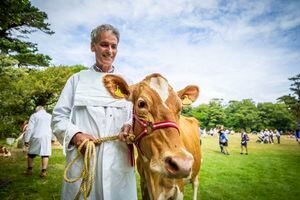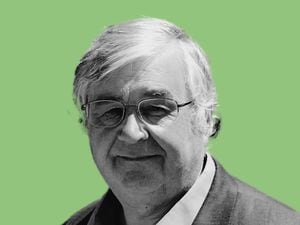Remembering the glory days
WITH the full confidence and belief that we are Covid-free (Bless you, Dr Brink), I have this week taken my first forays into the Real World, breaking my almost five months long self-imposed isolation.

I visited my first retail establishment this year and, despite doing a reasonable impression of Davros, creator of the Daleks, on my mobility scooter I managed to extricate myself without exterminating anyone.
My second adventure was to attend the Royal Agricultural & Horticultural Society Show at Saumarez Park. This was a real trip down memory lane and even though there was a slight risk of encountering visitors from the Isle of Man I put my trust once again in Dr Brink and set off at a brisk 8mph.
I really do have to set the scene here because many of you will never have attended or even heard of the Royal Show. This was the leading show of the year where, unlike the South, West and North Shows, all the island’s cattle could compete against each other and not just those in the relevant parishes. The Royal Show was and is the island-wide voting equivalent for selecting the champions of our island breed.
Back in the dim mists of time this was THE event in the cow calendar. On hundreds of farms dozens of bulls, cows and heifers had been meticulously prepared with even their horns sandpapered down ready for a dollop of Guernsey butter to be applied, bringing them out in a beautiful polished finish. Tails were washed and fluffed and coats brushed and groomed until there wasn’t a hair out of place.
The cleaning and primping would continue at the show field itself and as far as the eye could see (slight exaggeration) there would be a line of beautiful animals spreading along the whole length of the park. Crowds would gather for the judging and classes of 20 or more animals competing against each other were not unusual. Expert judges were often brought from the mainland and their job was not an easy one.
Competition, both friendly and not so friendly, was rife and long-running disagreements, almost feuds, could be traced back to a difference of opinion of who should be first and who second. This was a serious business and at one time huge demand for Guernsey cattle attracted droves of buyers all willing to pay silly money for the winning animals.
It’s hard to believe now but there was a time when a single Guernsey cow standing in a field could be worth more than the field or even the entire farm. Bulls were sold at prices the equivalent of four or five average houses. This was a real industry with a real product that brought great wealth into our island and put Guernsey on the map.
Back to today. The show is a shadow of its former glory. The bull lines are empty. The cow lines only a fraction of the length of days gone by. The competition is almost non-existent with many classes featuring a single animal being judged against itself and a class of four being considered a ‘big’ class. Not like the group classes of old when perhaps seven or eight groups of four animals each would compete against each other.
The trophy table is weighed down by a mass of splendid gleaming cups in all shapes and sizes and each competing with each other to be the grandest example of the silversmiths’ art. Some are so old and have been awarded so many times that the black plinths on which they stand are tiered like wedding cakes and decorated with tiny shields, each bearing the name of the winner.
Those shields are a record of our farmers and there are many familiar names there which are no longer connected with dairy farming. It pleases me to see my family name appear many times on virtually all of the trophies on that table and I can remember our sideboard at home groaning under their weight.
Happy days.
Now we have but 14 farms and there is no export market for Guernsey cattle, which makes the shows a little less important and in reality there is little point in showing cattle here any more. But I am so pleased that some of our commercial farmers take the time and effort to keep the tradition going. The number of entries may be low, possibly similar numbers to the trophies, but the enthusiasm and pride of the owners showing off their animals is definitely of a high order.
The quality and condition of the animals at the show was certainly tip-top and the turnout, although good, may not have quite reached the fevered levels of the highly competitive past events but was pretty close. I take my hat off to the farmers who go to all the effort to keep the tradition going and hope they will continue to do so for many years to come.
It is all about tradition now. The 1,400 or so cows that we have keep us self-sufficient in milk. That in itself is a wonder because the Guernsey cows now each give more milk than we would have thought possible 50 years ago. No longer is the dairy industry a major wealth creator and employer. Bulls cannot be sold today for the sort of money that could build fancy farmhouses. And if the milk monopoly was ended then the industry could not survive producing milk at a fair market price.
The States of Guernsey has put aside £26m. to replace our old Dairy. That’s an enormous amount to process the milk from 1,400 cows and commercially I can’t see any private concern spending as much.
I say let it be a memorial to a great industry. Build it big, build it proud and let it be a testament to our future generations that Guernsey has and can again build world-class industries if we put our minds to it. We see everywhere around us memorials to our quarrying industry, we have place and road names such as the Salerie and the Couture as memorials to salting fish and knitting.
Industries come and go but we keep soldiering on. The catchphrase ‘Revive and Thrive’ historically doesn’t match with what we actually did to dig ourselves out of industry failures. We revived pretty much nothing but thrived nevertheless.
At some time in the future, when I gaze upon the Great Guernsey Memorial Dairy with its golden spire, I will see it as another line drawn under another industry. In the same way, I wonder if some of our current industries are not worth reviving after Covid and it is time for us to move on.
Tourism, possibly?





